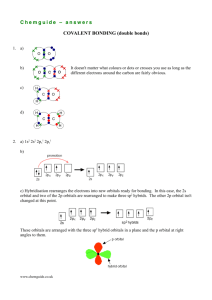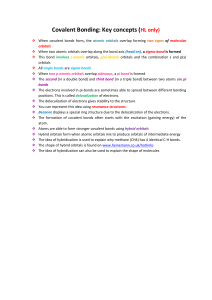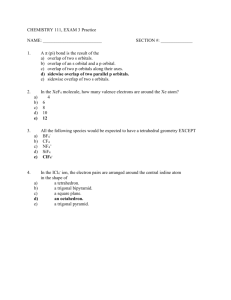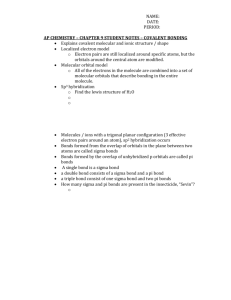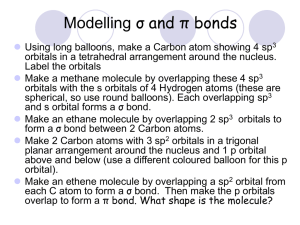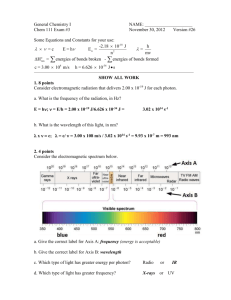AP Chemistry Unit 3 Summary: Chemical Bonding & Structure
advertisement
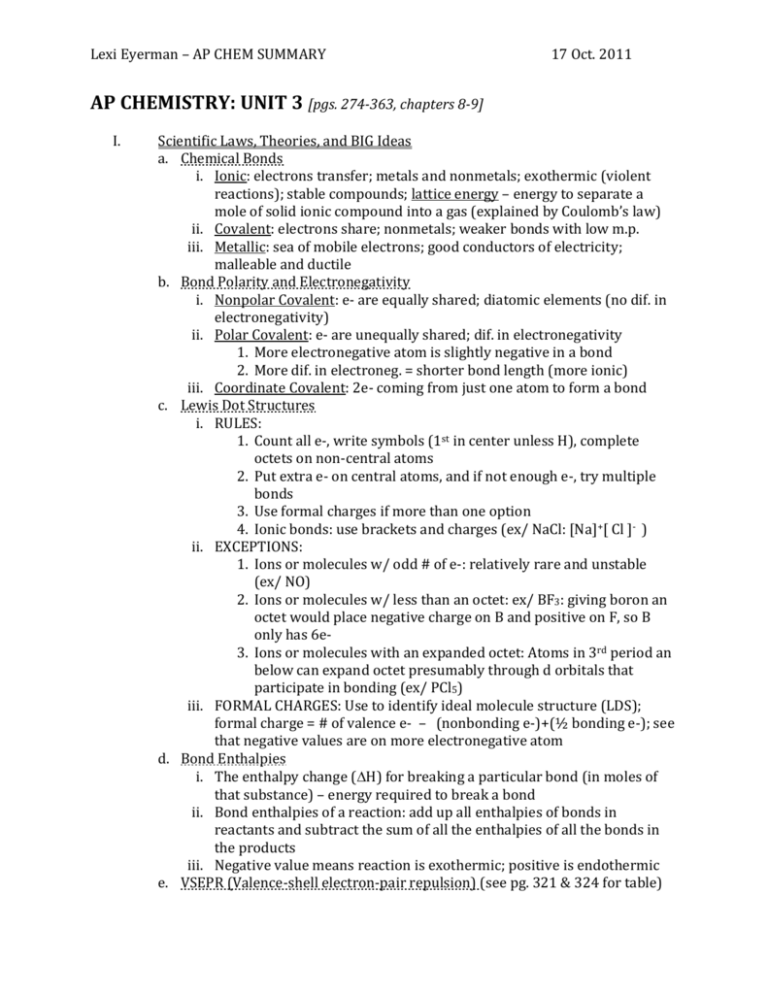
Lexi Eyerman – AP CHEM SUMMARY 17 Oct. 2011 AP CHEMISTRY: UNIT 3 [pgs. 274-363, chapters 8-9] I. Scientific Laws, Theories, and BIG Ideas a. Chemical Bonds i. Ionic: electrons transfer; metals and nonmetals; exothermic (violent reactions); stable compounds; lattice energy – energy to separate a mole of solid ionic compound into a gas (explained by Coulomb’s law) ii. Covalent: electrons share; nonmetals; weaker bonds with low m.p. iii. Metallic: sea of mobile electrons; good conductors of electricity; malleable and ductile b. Bond Polarity and Electronegativity i. Nonpolar Covalent: e- are equally shared; diatomic elements (no dif. in electronegativity) ii. Polar Covalent: e- are unequally shared; dif. in electronegativity 1. More electronegative atom is slightly negative in a bond 2. More dif. in electroneg. = shorter bond length (more ionic) iii. Coordinate Covalent: 2e- coming from just one atom to form a bond c. Lewis Dot Structures i. RULES: 1. Count all e-, write symbols (1st in center unless H), complete octets on non-central atoms 2. Put extra e- on central atoms, and if not enough e-, try multiple bonds 3. Use formal charges if more than one option 4. Ionic bonds: use brackets and charges (ex/ NaCl: [Na]+[ Cl ]- ) ii. EXCEPTIONS: 1. Ions or molecules w/ odd # of e-: relatively rare and unstable (ex/ NO) 2. Ions or molecules w/ less than an octet: ex/ BF3: giving boron an octet would place negative charge on B and positive on F, so B only has 6e3. Ions or molecules with an expanded octet: Atoms in 3rd period an below can expand octet presumably through d orbitals that participate in bonding (ex/ PCl5) iii. FORMAL CHARGES: Use to identify ideal molecule structure (LDS); formal charge = # of valence e- – (nonbonding e-)+(½ bonding e-); see that negative values are on more electronegative atom d. Bond Enthalpies i. The enthalpy change (H) for breaking a particular bond (in moles of that substance) – energy required to break a bond ii. Bond enthalpies of a reaction: add up all enthalpies of bonds in reactants and subtract the sum of all the enthalpies of all the bonds in the products iii. Negative value means reaction is exothermic; positive is endothermic e. VSEPR (Valence-shell electron-pair repulsion) (see pg. 321 & 324 for table) Lexi Eyerman – AP CHEM SUMMARY 17 Oct. 2011 i. Electron domain: region where electrons will most likely be found ii. Electron domain geometry: arrangement of e- domains around central atom; includes both bonding and nonbonding domains iii. Molecular geometry: actual shape of molecule based only on bonding eiv. Nonbonding e- pairs take up more space than bonding electrons v. Multiple bonds take up more space than single bonds f. Hybridization: the process of mixing and changing atomic orbitals as atoms approach each other to form bonds; explains geometries of molecules i. sp hybrid: if s atomic orbital is full, there are no unshared e-, so it appears it won’t want to bond; 1 s e- is promoted to the p orbital, and 1 s orbital and 1 of the p orbitals combine to form 2 sp orbitals ii. sp2 hybrid: mix 1 s orbital with 2 p orbitals; forms 3 sp2 orbitals iii. sp3 hybrid: mix 1 s orbital with 3 p orbitals; forms 4 sp3 orbitals iv. sp3d hybrid: 1 s, 3 p, and 1 d orbital; forms 5 sp3d orbitals v. sp3d2 hybrid: 1 s, 3 p, and 2 d orbitals; forms 6 sp3d2 orbitals vi. DETERMINING HYBRIDIZATION: Draw LDS, determine VSEPR shape, see which hybrid is needed g. Multiple Bonds: = end to end overlap; = side to side overlap i. is stronger than b/c sigma has more overlap of eii. Delocalized e-: the bond is not found in one location but moves around II. Equations/ Calculations: a. Formal Charge = valence electrons – (unshared e- + ½ bonding e-) b. Bond enthalpy of a reaction: ∆𝐻𝑟𝑥𝑛 ∑(𝑏𝑜𝑛𝑑 𝑒𝑛𝑡ℎ𝑎𝑙𝑝𝑖𝑒𝑠 𝑜𝑓 𝑏𝑜𝑛𝑑𝑠 𝑏𝑟𝑜𝑘𝑒𝑛) − ∑(𝑏𝑜𝑛𝑑 𝑒𝑛𝑡ℎ𝑎𝑙𝑝𝑖𝑒𝑠 𝑜𝑓 𝑏𝑜𝑛𝑑𝑠 𝑓𝑜𝑟𝑚𝑒𝑑) III. Favorite Topic/ Activity: Lewis Dot Structures were my favorite activity; they help me to visualize the bonds in the molecule (and I do well with visual aids) IV. Least Favorite Topic/ Activity: Hybridization was my least favorite activity; they were hard to understand visually for me (and I wasn’t there when it was taught… making it that much harder to understand).

